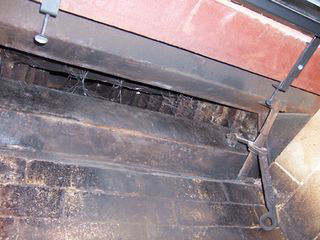
by blogediter | Mar 9, 2018 | Chimney Plugs
Damper Handle
Q: Jason, Most of the diagrams on the Chimney Balloon.us show fireplace dampers with the handle in the middle of the damper door. On my fireplace, I have the damper handle way off to the right side (see the two attached pictures with the damper open and damper closed). Does this make a difference? Should I still install a Chimney Balloon above my damper? I measured the area above the damper and it is 11″ deep and 30″ across – TY
A: Dear TY, Thank you for the two damper photos. The opening and closing mechanism are unique on this fireplace damper. I have seen this type of damper before, but have never take a photo of it. I can tell by the cobwebs hanging in your open flue (in the open damper photo) that you must not use this fireplace very much.
In this particular application, I would recommend that you install the Chimney Balloon above the damper. The handle and other damper hardware are on the way below the damper and it looks like the firebox opens to the hearth almost immediately below the damper so there is not much lintel there.
Since your measurements above the damper are 30″x11″ and it looks like the flue stair steps smaller as it goes upward I would go with a 33×12 Chimney Balloon in this fireplace flue. You can always go a little larger (up to 6″ or so) in the Chimney Balloon size you purchase, just never buy one smaller than your measurements. – Jason
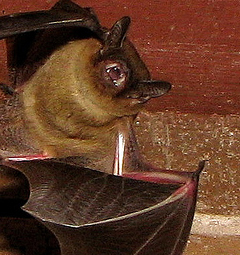
by blogediter | Mar 5, 2018 | Chimney Plugs
Bat in Chimney
Q: Jason, I have quite a few bats in my chimney. I had one sneak down through the damper last night and start flying around the house until I whacked him. This bat thing is not cool! Will a Chimney Balloon keep them out of the house and how do I get the bats out of the chimney? – BG
A: Hi BG, I have had to whack a few interior bats in my day too. The little critters can get through a gap as small as 3/8 inch so they can get in about anywhere. A fireplace chimney damper is often as good of a place as any to gain entry to your home since there are often gaps in the damper door once they start warping from the heat.
Here is what you do… Get a Chimney Balloon installed just above your damper door and seal the flue nice and tight and inflate the Chimney Balloon nice and tight. Then go to the roof (if you have access to the chimney and take a cloth bag with some moth balls in it and toss it down the chimney so it lands on the top of the Chimney Balloon. The mothballs will annoy the bats and they will fly up and out to get away from it. Make sure you don’t just do the mothballs without the Chimney Balloon though since you could end up coaxing them right into the house if you don’t have the chimney sealed off above the hearth.
Since the Chimney Balloon is in there tight the smell from the mothballs should stay in the chimney not enter the home.
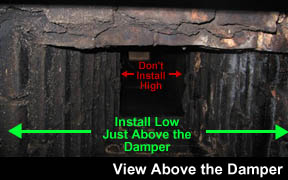
by blogediter | Mar 2, 2018 | Chimney Plugs
Smoke Chamber Install
Q: Jason – I previously ordered a 9X9 Chimney Balloon and it works fine for the flue (size 8″ square). What I don’t like about it is that the flue is about 5″ higher than the 12″ X 16″ smoke chamber. So when I place the 9×9 Chimney Balloon in the flue I have to really reach to get a good fit. Instead of getting your Chimney Balloon extension rod I figure it would be best to try and get another him Chimney Balloon to fit the 12 X 16 area above the damper. As I mentioned the 12 X 16 area (smoke chamber?) has only a 5-inch height then the flue begins. So if I understand correctly order a custom 12 X 18 and this would seal the area above my damper (12 X 16 X 5) Thanks, DT
A: Hi DT, It is true that a lower install location makes putting in a Chimney Balloon much easier, so I agree a larger Chimney Balloon for the smoke chamber is the way to go.
A custom 12×18 Chimney Balloon would work well for a 12″x16″ area. Remember, a Custom Chimney Balloon requires a 14 day build time, but it is worth the wait to get the correct size. You could consider a stock 24×12 Chimney Balloon, but I am concerned there will be too much extra Chimney Balloon material if you went with this size. If you get a Chimney Balloon that is more than 6″ oversize the extra material can make the install more difficult.
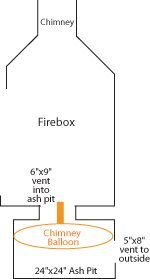
by blogediter | Feb 21, 2018 | Chimney Plugs
Fireplace ash pits that are cold and drafty
Q: Jason, I’m trying to determine which size Chimney Balloon to get. This is not for the chimney, but for an opening at the bottom of the fireplace that ends up going outside. (I have no idea what the opening is for, maybe as a drainage for ashes?)
The opening in the bottom of the fireplace is about 6 X 9, and it drops straight down to a large rectangular area under the house. That area has a vent to the outside of the house. The vent opening is 5″ tall X 8″ wide, but the area immediately inside the vent is much larger, probably 24 X 24.
- Should I get a 9 X 9 size and try to plug up one of the openings? If so, which one?
- Or should I get a bigger size, and try to plug the area between the openings? If so, what size? Thanks, BT
A: Hi BT, It is possible to use a Chimney Balloon to stop draft from coming in through the ash pit chute. If you really want the handle of the Chimney Balloon down and out of view you will need to get a larger 24×24 Chimney Balloon and put it in the ash chamber area (as seen in the picture). If you don’t mind the Chimney Balloon handle sticking up into the firebox area then you can put a 9×9 Chimney Balloon in the small 6″x9″ chute going down to the ash chamber as long as that chute has 6″ or more in height for the Chimney Balloon to lodge in. – Jason
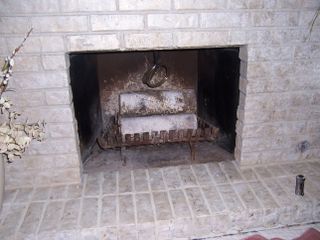
by blogediter | Feb 19, 2018 | Chimney Plugs
Fireplace Damper
[Q: Jason, I previously ordered a 9X9 Chimney Balloon fireplace damper and it works fine for the flue (size 8″ diameter). What I don’t like about it is that the flue is about 5″ higher than the 12″ X 16″ smoke chamber. So when I place the 9×9 Chimney Balloon in the flue I have to really reach to get a good fit.
Instead of getting your extension rod I figure it would be best to try and get another balloon to fit the 12 X 16 area above the damper. As I mentioned the 12 X 16 area (smoke chamber?) has only a 5-inch height then the flue begins. So if I understand you correctly order a custom 12 X 18 and this would seal the area above my damper (12 X 16 X 5)
Thanks, DT
A: Hi DT, You can send back your current 9×9 Chimney Balloon and get a custom 18×12. It would work well for a 12″x16″ area. Remember, a Custom Chimney Balloon requires a 14 day build time. You could order a standard 24×12 that would ship right away, but I am concerned there will be too much extra Chimney Balloon material. It really would be worth the wait to get the correct size. – Jason
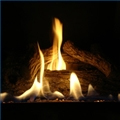
by blogediter | Feb 14, 2018 | Chimney Plugs
Vented gel burner log
Q: I have a small, 100-year-old fireplace that I do not use because the chimney is unlined and I can’t afford to get it lined. There’s no damper either. I have decided to put a fake log and an alcohol gel burner (ventless) in there for the ambiance and a small bit of extra heat. I intend to block off the top of the firebox with a steel plate and fireplace caulk. This should keep air from going up the chimney, but will not stop heat loss via radiation.
Do you think, if I installed a Chimney Balloon 4 to 6 feet above the metal plate, it would survive? These gel burners put out 3000 BTU per hour per can, and I might at times burn 3 cans at a time, for a total 9000 BTU per hour. The flames would not be high enough to touch the metal plate. Thanks, ADH
A: Dear ADH, The Chimney Balloon will trigger its release at about 180-200 degrees Fahrenheit. I am certain it will only take about 5 minutes for a couple of rocket fuel… I mean… gel fuel, canisters to get the flue temp on the other side of your metal plate up to that temp. That metal will conduct pretty well once you get it cooking.
I do want to give you a fair warning about the adaptations you are planning to do to your fireplace. This type of DIY fireplace project is what makes home insurance agents get ulcers. When you self-seals a fireplace flue with a metal plate in order to save heat you are definitely taking your chances. The heat will spill around the lintel of your fireplace and go right up to the mantle and be facing wall. When your mantel clock bursts into flames and your Hummel figurines neatly arranged on the mantle melt from the spilled heat it will be a bit too late to correct the error.
I’m being tongue-in-cheek here, but seriously, altering an existing fireplace to trap heat is not a DIY kind of thing. I don’t even know many fireplace professionals that will try it (unless it is at their in-laws). You might luck out and fix it up just right, and you might create a real safety risk. – Jason
Q: Jason, Thanks for your input about the chimney pillow and the concern about the fireplace adaptation. Before planning to do all this, I consulted specs from several manufacturers for ventless gas logs placed in existing fireplaces.
According to specs, ventless gas logs for this size fireplace, burned with the damper closed, can safely run at considerably more than 9000 BTU given the distance between the top of this particular fireplace opening (which has a hood) and the mantel. The metal plate will be in the same place a damper would be– if there was one– and dampers are metal, so I don’t see the problem. (It will only be touching firebrick and will be several inches back from the fireplace opening, also.)
A number of people in old houses here have had their fireplaces blocked off and big, honking gas logs installed without incident– seems to be standard practice around here anyway.
A: Dear ADH, I am very relieved to hear you researched it fully first, and it sounds like you covered your bases. Good luck with your fireplace project. – Jason





